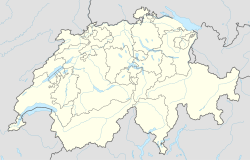Villars-Burquin
| Villars-Burquin | |
|---|---|
| Former municipality of Switzerland | |
| Coordinates: 46°50′N 06°37′E / 46.833°N 6.617°ECoordinates: 46°50′N 06°37′E / 46.833°N 6.617°E | |
| Country | Switzerland |
| Canton | Vaud |
| District | Jura-Nord Vaudois |
| Government | |
| • Mayor | Michel Cerinotti |
| Area | |
| • Total | 4.82 km2 (1.86 sq mi) |
| Elevation | 749 m (2,457 ft) |
| Population | |
| • Total | 565 |
| • Density | 120/km2 (300/sq mi) |
| Demonym(s) | Les Roitelets |
| Postal code | 1423 |
| SFOS number | 5570 |
| Surrounded by | Romairon, Vaugondry, Fontaines-sur-Grandson, Mauborget |
| Website |
www Profile (French), SFSO statistics |
Villars-Burquin is a former municipality in the district of Jura-Nord Vaudois in the canton of Vaud in Switzerland.
The municipalities of Fontanezier, Romairon, Vaugondry and Villars-Burquin merged on 1 July 2011 into the new municipality of Tévenon.
Villars-Burquin has an area, as of 2009[update], of 4.82 square kilometers (1.86 sq mi). Of this area, 1.6 km2 (0.62 sq mi) or 33.2% is used for agricultural purposes, while 2.94 km2 (1.14 sq mi) or 61.0% is forested. Of the rest of the land, 0.26 km2 (0.10 sq mi) or 5.4% is settled (buildings or roads) and 0.02 km2 (4.9 acres) or 0.4% is unproductive land.
Of the built up area, housing and buildings made up 3.9% and transportation infrastructure made up 0.8%. Out of the forested land, 56.4% of the total land area is heavily forested and 4.6% is covered with orchards or small clusters of trees. Of the agricultural land, 3.7% is used for growing crops and 19.9% is pastures, while 1.9% is used for orchards or vine crops and 7.7% is used for alpine pastures.
The municipality was part of the Grandson District until it was dissolved on 31 August 2006, and Villars-Burquin became part of the new district of Jura-Nord Vaudois.
The blazon of the municipal coat of arms is Or, on two Pine Branches in saltire a Wren proper.
Villars-Burquin has a population (as of 2009[update]) of 565. As of 2008[update], 8.2% of the population are resident foreign nationals. Over the last 10 years (1999–2009 ) the population has changed at a rate of 18%. It has changed at a rate of 15.7% due to migration and at a rate of 2.3% due to births and deaths.
...
Wikipedia


